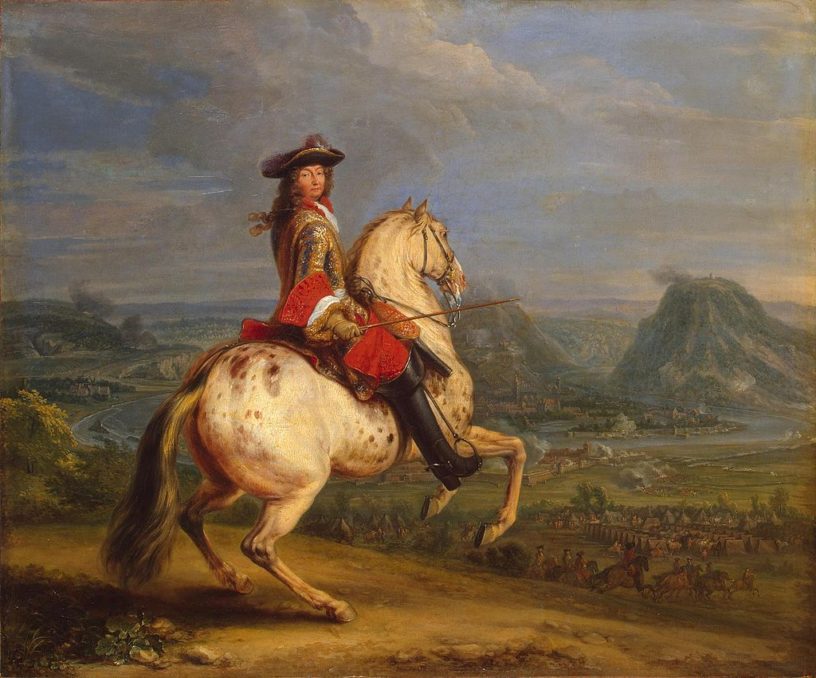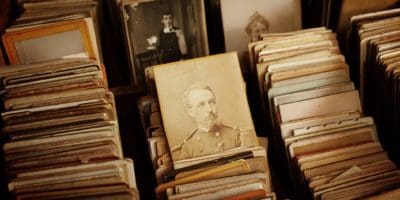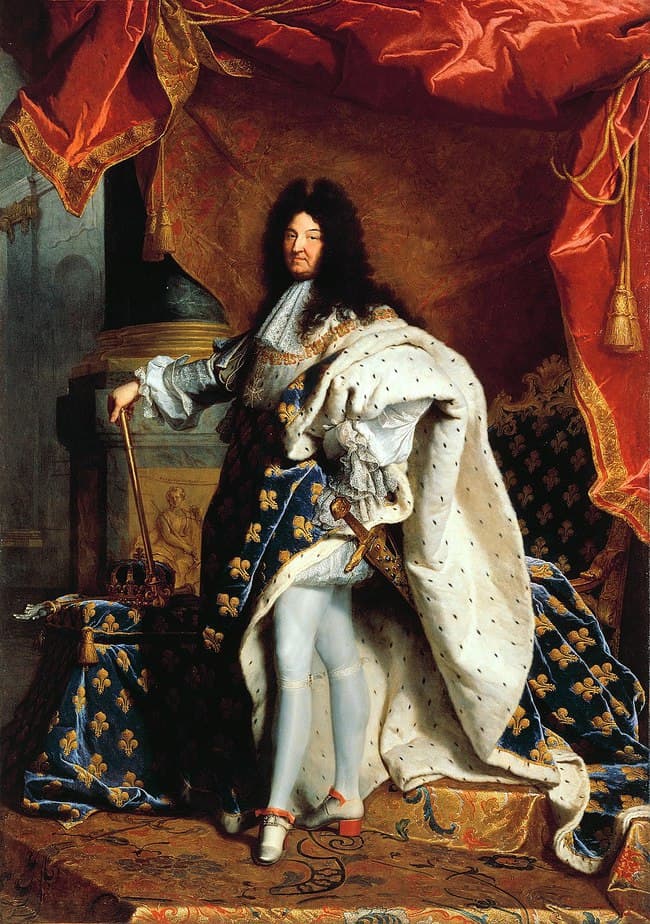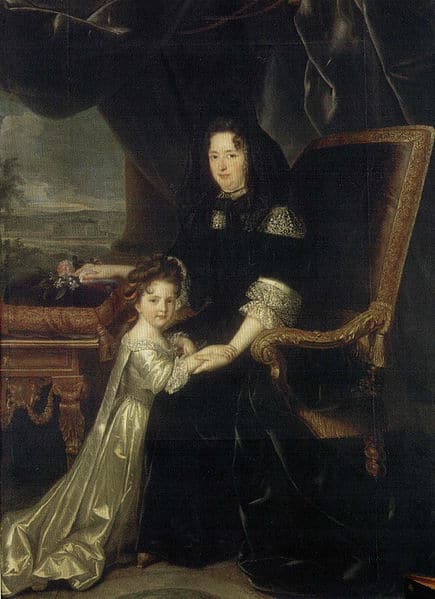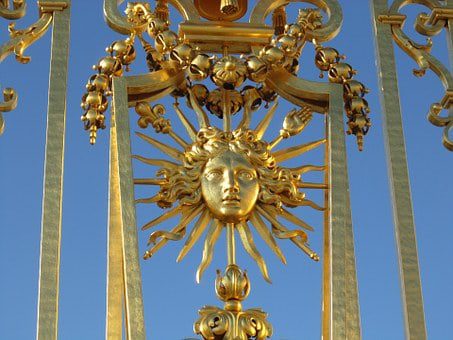Top 10 facts about Louis XIV
Louis XIV is without a doubt the most renowned of French kings. The 17th and 18th monarch reigned over France for 72 years, reaching the top of the list of kings who ruled the longest in the country. The son of king Louis XIII and of famous Anne of Austria – who will forever remain in cinema history as the woman surrounded with her devoted Musketeers among which D’Artagnan – Louis XIV left a major mark on the country he reigned over.
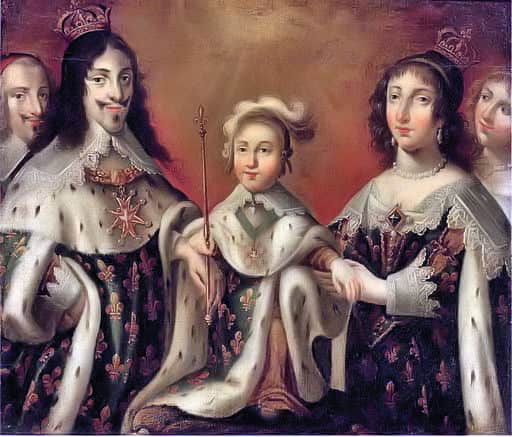
Young King Louis XIV surrounded by his parents, Louis XIII and Anne of Austria, and by Cardinal Richelieu and the Duchess of Chevreuse. – Public Domain, source: Wikimedia Commons
Although the most studied and famous of kings, there are a few anecdotes you might not yet know about Louis XIV, among which the following ones:
1. The king’s anal fistula
As I previously mentioned, the reign of Louis XIV is exceptionally long for his time. The life expectancy was then much shorter than it is now. What is less known is that the Sun King’s reign came close to being a lot shorter, about halfway through. Indeed, in 1686, Louis XIV suffered from an anal fistula requiring a surgical intervention. Before such a risky operation, legend has it that the royal surgeon trained on 75 people chosen in the Versailles Hospital. The operation was a success and the king survived.
As surprising as it may seem, it might also have been at the origin of the United Kingdom anthem, “God Save the King”. Indeed, composer Lully wrote a celebration anthem to celebrate the king’s good recovery. In 1714, British king Georges I’s official composer, as he was visiting Versailles, would have heard the anthem and brought it back to his home country. There, the anthem would have become a huge success and is, still to date, the traditional anthem of the British monarchy.
Although uncertain, this version is somewhat claiming that the king’s anal fistula is the origin of the British anthem…
2. From mistress to wife
It was commonly known and accepted that the French kings had mistresses, in addition to their official wife, the queen. Mistresses were much more put forward at the Court than the queen even was. The latter only had two roles at the Versailles Court: ensure the king had descendants, and act in charity work.
For all the rest, including the common Court life and the king’s entertainment, the role bestowed upon the royal mistresses. Among the many, three main mistresses dominate Louis XIV’s long reign: Louise de Lavallière, the Marquess of Montespan and Madame de Maintenon. Never was the role of the mistress to ever replace the queen: she was always supposed to only be his companion. Of the three, however, the latter, Madame de Maintenon, will know a fate that none other had.
Originally, Madame de Maintenon was supposed to be the nanny of the children Louis XIV had with his previous mistress, Madame de Montespan. As he gets older, and tired of Madame de Montespan’s personality, Louis XIV slowly turned to Madame de Maintenon who became his confident, his lover. The death of queen Marie-Thérèse, marked a turning point in the mistress’s life.
Despite all usages and the fact that Madame de Maintenon was not part of the higher nobility, the king decided to marry her, less than three months after the passing of his wife. The wedding took place in high secrecy, which means she only became the king’s wife, but not the queen. Madame de Maintenon thus benefited from a very special place at the Court and in the king’s life and heart, until the very end of his reign. This is the first time in French history that a king married one of his mistresses.
3. The king’s “chair of affairs”
The Versailles Court is dominated by an important set of implicit rules called “Etiquette”. The Etiquette qualifies all the rules of decency and the behavior the Court must adopt in presence of the royal family. Since Louis XIV’s life was entirely staged to magnify every aspect of it, the king created some privileges which may seem very strange nowadays.
After waking up in presence of some privileged courtiers, the king was sitting down on his “chair of affairs”, which is a pierced seat from where he agreed to his courtiers’ requests all the while sitting on what one may now call…his toilets.
Of course, the life at Versailles could be more glamorous. Why not get a glimpse of it with our guide tours of Versailles? Click here to know more.
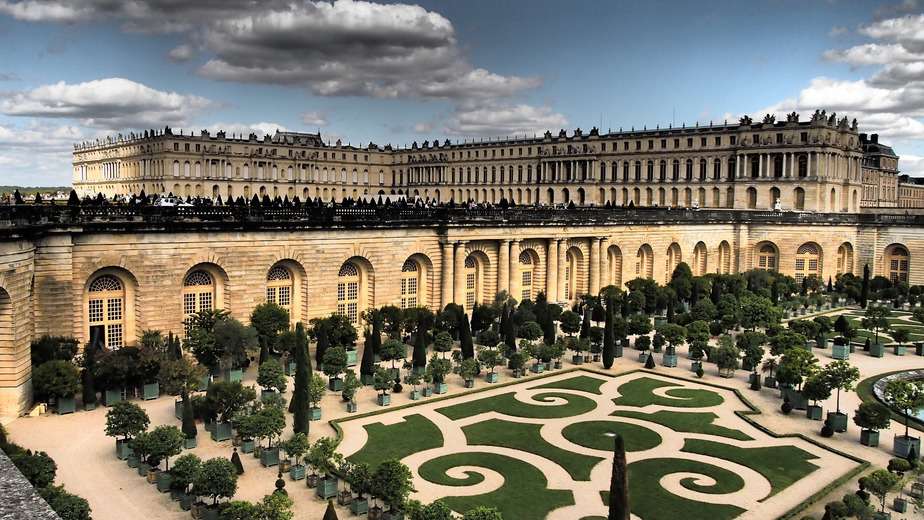
The Palace of Versailles was the heart of the Royal Court during Louis XIV’s reign. The etiquette was strict and sometimes somewhat strange… Source: Pixabay CC0
4. The birth of Louis XIV
At birth, Louis XIV was considered a miracle child. Indeed, his parents Louis XIII and Anne of Austria had not yet given an heir to the crown. For more than twenty long years, France and the royal family were waiting for a dauphin – the king’s first son – to ensure to dynasty to go on.
Since king Louis XIII clearly preferred the company of men to that of the queen, all past attempts to ensure a legitimate heir had been unfruitful. It was only after 21 years of marriage that the queen finally got pregnant, of a boy. The baby was named Louis Dieudonné (literally “gift from God” in French).
The enthusiasm was such that the whole country celebrated. For three continuous days, Paris turned into a huge party, lit up by fireworks displays. Columnists of the time ensured that such party in honor of a new-born king was never seen before, from human memory. Should Louis XIII have continued to avoid the queen’s bed, the king who reigned the longest on France might never have seen the light.
5. The unusual initiation to sexual pleasure
As he was a teenager, Queen Anne of Austria chose to have her son Louis XIV initiated to sexual pleasures. The woman quickly chose the one who was to take her son’s virginity. Her husband’s attraction to men probably fed her fears that Louis XIV might follow the same path which may explain why she precipitated such decision.
She picked one of her lady-in-waiting, but certainly did not choose her randomly. Indeed, the regent queen chose the Baroness of Beauvais, also nicknamed Cateau-la-Borgnesse (“One-eyed Cathy”), an ugly woman missing one eye.
The surprising choice to choose such a woman to help her son lose his virginity probably came from the wish to avoid him falling in love with her, which would compromise a hypothetical future marriage of Louis with a woman who would serve the political interests of the Kingdom.
The Baroness of Beauvais was in charge of the king’s sexual education between the age of 14 and 16. In return, Louis XIV gave her a castle as well as an annuity.
6. The Palace of Versailles
It is commonly accepted that the Palace of Versailles is the main architectural masterpiece of the reign of Louis XIV. But actually, the magnificent castle, which is the symbol of the absolute monarchy, was not only the work of the Sun King.
In Louis XIV’s mind, the castle was to become the most sumptuous home of the country. Louis XIV wants Versailles to be a huge theater to his own glory. Every single detail in the Palace aims at emphasizing the grandeur of his reign. However, lesser known is the small hunting pavilion which stood there before, and which was often used by his father – and previous king – Louis XIII.
The hunting pavilion was not taken down. Actually, it still very much exists since it composes most of the central wing of the Palace. The castle took years before being finished. Upon its completion, the King decided that the castle would be his home, but also the home of the Court – mostly high nobility – and that of the members of his government.
The king’s choice to set the Court at Versailles was not just an egocentric and artistic choice. Indeed, by transferring it all in one centralized location, Louis XIV could then watch and control the greatest families of French high nobility and avoid revolts. Most of all, Louis XIV wants to avoid the repetition of the Fronde, a civil war which took place during his childhood, during which his legitimacy was challenged by some nobles.
Versailles then serves as his main tool to claim that he is a king almighty and that his legitimacy cannot be questioned.
Still not convinced that Versailles is special? Click here to see by yourself !
7. Bets and death
By the end of his long life, Louis XIV was very ill, as he often was during his life. The frail health of the king was often challenged throughout his life: smallpox, tapeworm, typhus, and many more… As the king neared the dusk of his life, bookmakers in England started betting on when the king of France would pass.
Upon learning this, the King was much affected. As he always did, and even though he was very weakened, he decided to look good by eating a lot. At the time, eating was considered a sign of good health. Louis XIV died in 1715.
8. The Man in the Iron Mask
Probably the most important legend of Louis XIV’s reign, the Man in the Iron Mask is one of the greatest mysteries. At the time, the king could decide to arrest anyone, by the simple use of a “lettre de cachet” (sealed prison order). First discrete, the legend of the Man in the Iron Mask was later put in the light by Voltaire who told the story of this mysterious prisoner whose name, age, and face were unknown. The reason of his imprisonment was unknown as well. Not much more was needed to feed the legend.
According to this legend, it was Louis XIV who gave the order that no one should see the man’s face and that he should be killed, should his identity be revealed. Even if the legend was not yet triggered, those who knew the Man in the Iron Mask noticed that he was treated with a respect that only high nobility prisoners got. Of course, guesses on who the man might have been quickly started circulating: some saw in him Nicolas Fouquet – the Finances Minister arrested by Louis XIV after allegedly using public money to build his Vaux-le-Vicomte Castle, others thought he was a foreign spy.
A last guess believe that the Iron Mask hid a twin brother to the king, who would have been taken away to avoid a family feud upon the legitimate succession to the throne. The Iron Mask has still not been formerly identified, to date.
9. The Sun as a symbol
No other symbol is more linked to the reign of Louis XIV than that of the Sun. Nicknamed the “Sun King”, Louis XIV loved being the center of attention and had a strong need for representation. The symbol of the Sun first came from that trait of personality.
Indeed, during a ballet, Louis XIV – who loved acting – played the part of the Sun. In this ballet, the dancers were the princes of French nobility. The powerful scene displaying the Sun – the King – around whom revolved other planets – understand here “the French Nobility” – was obviously understood as a symbolic claim that the King is at the center of everything and that all the others are here to revolve around him without ever reaching him.
The famous ballet became so popular that the King was quickly nicknamed “the Sun King”. Enjoying this vision, Louis XIV took this emblem for the rest of his life.
10. Learning war in the gardens
After his father’s passing (Louis XIII), young 4-year-old Louis XIV becomes the king. The new king’s godfather, Cardinal Mazarin, hired a tutor to ensure a proper education to Louis.
The King is taught all the topics required to exercise as a monarch. Including these topics is the matter of war. In addition to the theoretical classes on this subject, small keeps are built in the gardens of the royal palaces. Surrounded with boys his own age, the King must take the lead of the childish army and manage to take the keeps.
By doing so, the King learnt the art of war but also the secrets of commanding and managing an army. This atypical education probably had a strong impact since the reign of Louis XIV mostly a time of war for France.
Planning a trip to Paris ? Get ready !
These are Amazon’s best-selling travel products that you may need for coming to Paris.
Bookstore
- The best travel book : Rick Steves – Paris 2023 – Learn more here
- Fodor’s Paris 2024 – Learn more here
Travel Gear
- Venture Pal Lightweight Backpack – Learn more here
- Samsonite Winfield 2 28″ Luggage – Learn more here
- Swig Savvy’s Stainless Steel Insulated Water Bottle – Learn more here
Check Amazon’s best-seller list for the most popular travel accessories. We sometimes read this list just to find out what new travel products people are buying.

 English
English